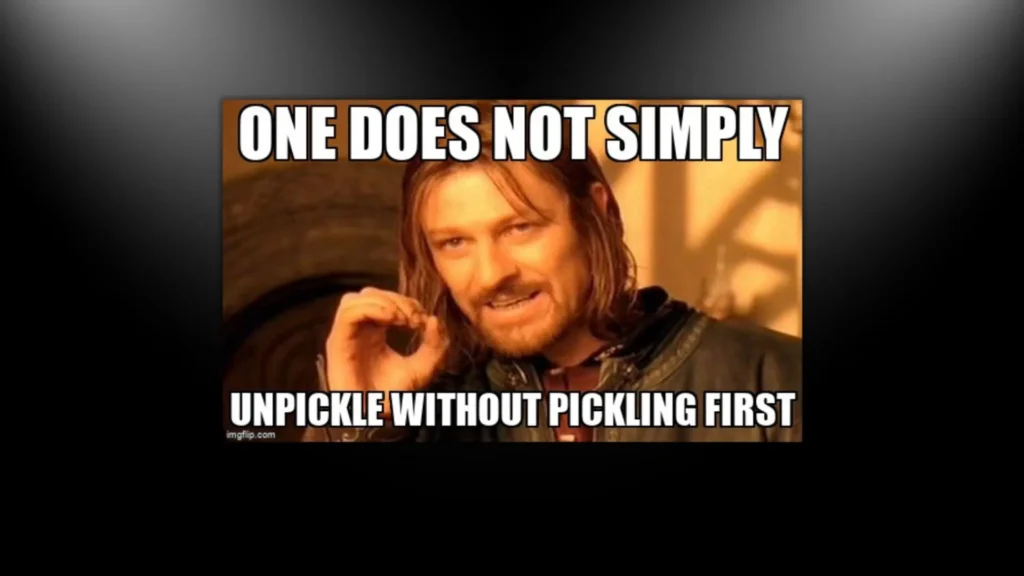
Have you ever wanted to save a complex Python object to a file or send it over a network without losing its attributes and behaviors?
If so, you might be interested in learning about pickling and unpickling in Python.
Pickling and unpickling are the terms used to describe the process of converting a Python object into a byte stream and vice versa, using the built-in pickle module.
This allows you to store or transfer any Python object, such as lists, dictionaries, classes or functions, and recreate them later in the same or another Python process.
In this blog post, you will learn:
- What is
picklingandunpicklingin Python and why they are useful - How to
pickleandunpickleobjects in Python using thepicklemodule - What are the advantages and disadvantages of
picklingandunpicklingin Python - What are some best practices for
picklingandunpicklingin Python
By the end of this blog post, you will be able to use pickling and unpickling in Python effectively and safely for your own projects.
Disclaimer: Pickling and unpickling in Python can pose security risks if you load data from untrusted sources, as it can execute malicious code during unpickling. You should only load data from trusted sources or verify its integrity before loading it. You can also use safer alternatives such as json or csv modules for loading data from untrusted sources.
What is pickling and unpickling in Python?
Pickling is the process of serializing a Python object into a byte stream that can be stored in a file or database, or sent over a network. Unpickling is the reverse process of deserializing a byte stream back into a Python object.
Pickling and unpickling can be useful when you want to:
- Save complex data structures to disk or database without having to write custom file formats or parsers
- Transfer data across different Python processes or machines without having to worry about compatibility issues
- Preserve the state and behavior of Python objects that are not easily reproducible by other means
For example, suppose you have a list of dictionaries that contains some information about your favorite athletes:
athletes = [
{"name": "Cristiano Ronaldo", "club": "Manchester United", "goals": 783},
{"name": "Lionel Messi", "club": "PSG", "goals": 778},
{"name": "Eden Hazard", "club": "Real Madrid", "goals": 173},
{"name": "Luis Suarez", "club": "Atletico Madrid", "goals": 507},
{"name": "Neymar", "club": "PSG", "goals": 411}
]If you want to save this data to a file or send it to another Python program, you can use pickling and unpickling to do so easily and efficiently.
How to pickle and unpickle objects in Python
To pickle and unpickle objects in Python, you need to use the pickle module. The pickle module provides two main functions: pickle.dump and pickle.load.
pickle.dump takes an object as an argument and writes it to a file-like object (such as an open file or a BytesIO object) in binary format. The file-like object must be opened in binary write mode (wb).
pickle.load takes a file-like object as an argument and reads the data from it. It returns the object constructed from the data. The file-like object must be opened in binary read mode (rb).
Here is an example of how to pickle and unpickle the athletes list from the previous section:
# Import pickle module
import pickle
# Open a file in binary write mode
with open("athletes.pkl", "wb") as f:
# Pickle the list and write it to the file
pickle.dump(athletes, f)
# Open the same file in binary read mode
with open("athletes.pkl", "rb") as f:
# Unpickle the list and assign it to a new variable
new_athletes = pickle.load(f)
# Print the new list
print(new_athletes)The output is:
[{'name': 'Cristiano Ronaldo', 'club': 'Manchester United', 'goals': 783}, {'name': 'Lionel Messi', 'club': 'PSG', 'goals': 778}, {'name': 'Eden Hazard', 'club': 'Real Madrid', 'goals': 173}, {'name': 'Luis Suarez', 'club': 'Atletico Madrid', 'goals': 507}, {'name': 'Neymar', 'club': 'PSG', 'goals': 411}]As you can see, the new_athletes list is identical to the original athletes list. The pickle module has preserved the structure and the content of the list.
You can also use the pickle.dumps and pickle.loads functions to pickle and unpickle objects in memory, without using a file. pickle.dumps returns a bytes object that contains the pickled representation of the object, while pickle.loads takes a bytes object and returns the unpickled object.
Here is an example of how to use these functions:
# Import pickle module
import pickle
# Create a sample Python object
data = {"a": [1, 2.0, 3, 4+6j], "b": ("character string", b"byte string"), "c": {None, True, False}}
# Pickle the object and assign it to a bytes object
pickled_data = pickle.dumps(data)
# Print the pickled data
print(pickled_data)
# Unpickle the data and assign it to a new variable
restored_data = pickle.loads(pickled_data)
# Print the restored data
print(restored_data)The output is:
b'\x80\x04\x95y\x00\x00\x00\x00\x00\x00\x00}\x94(\x8c\x01a\x94]\x94(K\x01G@\x00\x00\x00\x00\x00\x00\x00K\x03\x8c\x08builtins\x94\x8c\x07complex\x94\x93\x94G@\x10\x00\x00\x00\x00\x00\x00G@\x18\x00\x00\x00\x00\x00\x00\x86\x94R\x94e\x8c\x01b\x94\x8c\x10character string\x94C\x0bbyte string\x94\x86\x94\x8c\x01c\x94\x8f\x94(\x89\x88N\x90u.'
{'a': [1, 2.0, 3, (4+6j)], 'b': ('character string', b'byte string'), 'c': {False, True, None}}As you can see, the pickled data is a bytes object that contains the binary representation of the data dictionary. The restored_data dictionary is identical to the original data dictionary.
What are the advantages and disadvantages of pickling and unpickling in Python?
Pickling and unpickling in Python have some advantages and disadvantages that you should be aware of before using them.
Some of the advantages are:
- Pickling can save memory space by compressing complex data structures into byte streams.
- Pickling can preserve the state and behavior of Python objects that are not easily reproducible by other means, such as classes or functions.
- Pickling can facilitate data transfer across different Python processes or machines without having to worry about compatibility issues.
Some of the disadvantages are:
- Pickling is not a secure or reliable way of storing or transferring sensitive data, as it can be tampered with or corrupted easily.
- Pickling can pose security risks if you load data from untrusted sources, as it can execute malicious code during unpickling.
- Pickling can cause compatibility issues if you use different versions of Python or different protocols for pickling and unpickling.
What are some best practices for pickling and unpickling in Python?
To use pickling and unpickling in Python effectively and safely, here are some best practices that you should follow:
- Choose an appropriate protocol version for your use case. The
picklemodule supports six protocol versions, from 0 to 5. The higher the protocol version, the more efficient and advanced it is, but it may not be compatible with older versions of Python. You can specify the protocol version as an argument to thepickle.dumporpickle.dumpsfunction. If you don’t specify it, the default protocol version will be used (which is 3 for Python 3.x). You can also use -1 to indicate the highest protocol version available. - Handle errors and exceptions gracefully. The
picklemodule may raise various errors or exceptions during pickling or unpickling, such asPickleError,UnpicklingErrororAttributeError. You should usetry-exceptblocks to catch these errors or exceptions and handle them appropriately, such as logging them, displaying them or aborting the operation. - Avoid loading data from untrusted sources. Loading pickled data from untrusted sources can pose security risks, as it can execute malicious code during
unpickling. You should only load data from trusted sources or verify its integrity before loading it. You can also use safer alternatives such asjsonorcsvmodules for loading data from untrusted sources. - Use custom classes with caution. Pickling custom classes can be tricky, as it depends on various factors such as
inheritance,attributes,methodsandreferences. You should make sure that your custom classes are well-defined and documented, and that they implement thegetstateandsetstatemethods to control how they are pickled and unpickled. You should also avoid changing the class definition or location after pickling it, as it may cause errors or inconsistencies during unpickling.
You can find the all written code in this blog post on replit.
Conclusion
In this blog post, you have learned:
- What is pickling and unpickling in Python and why they are useful
- How to pickle and unpickle objects in Python using the pickle module
- What are the advantages and disadvantages of pickling and unpickling in Python
- What are some best practices for pickling and unpickling in Python
By following these tips and techniques, you can use pickling and unpickling in Python effectively and safely for your own projects.
If you found this blog post helpful, please share it with your friends or colleagues who might be interested in learning more about pickling and unpickling in Python.
And if you have any questions or feedback, please leave a comment below. I would love to hear from you!
Thank you for reading and happy coding! 😊
